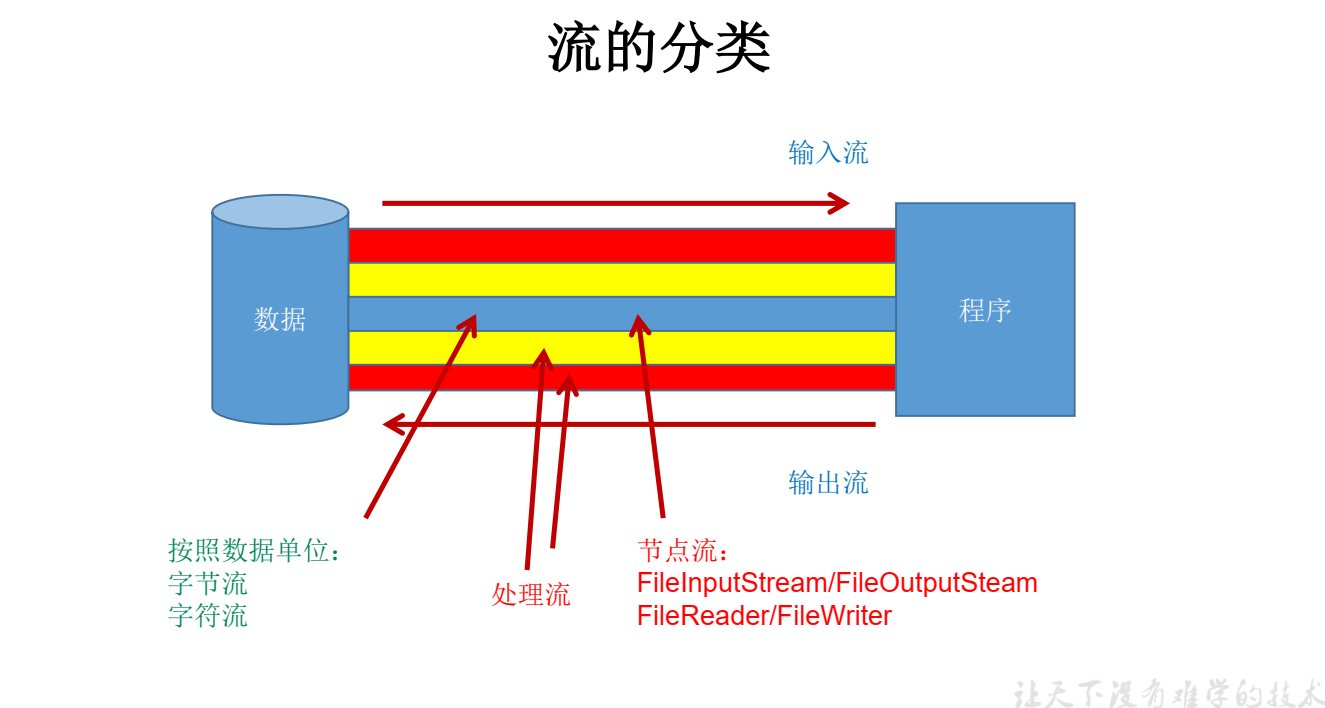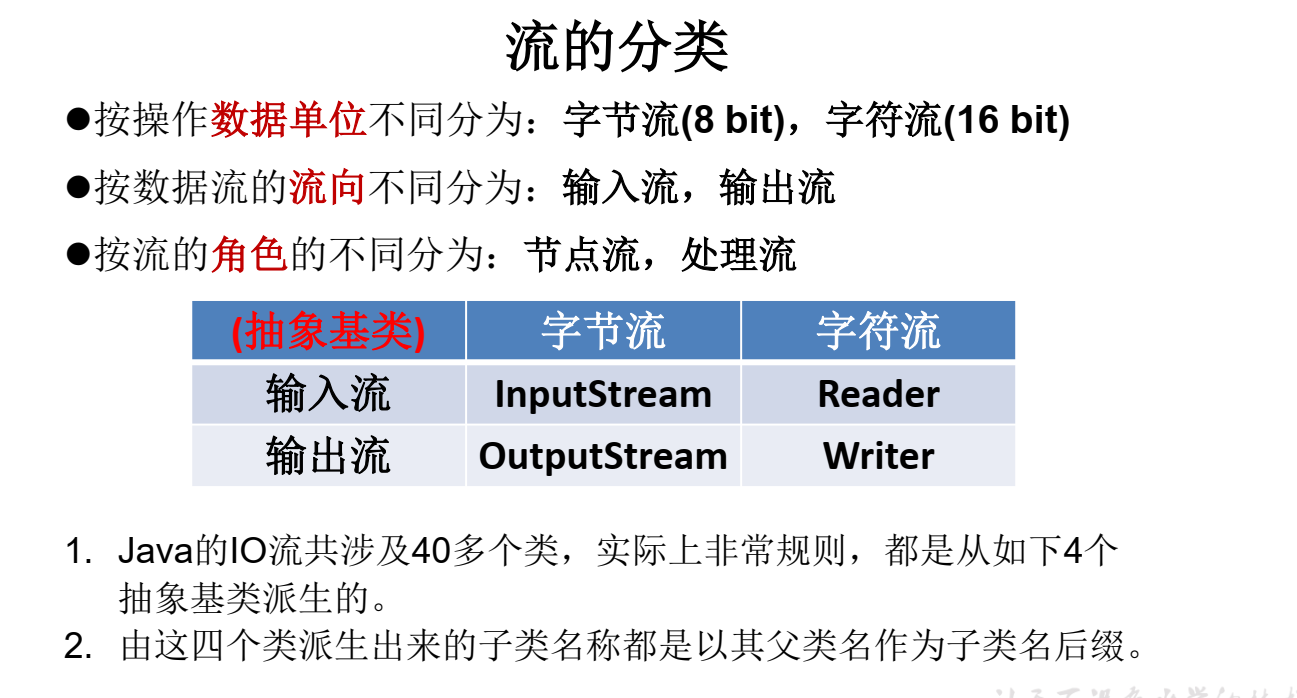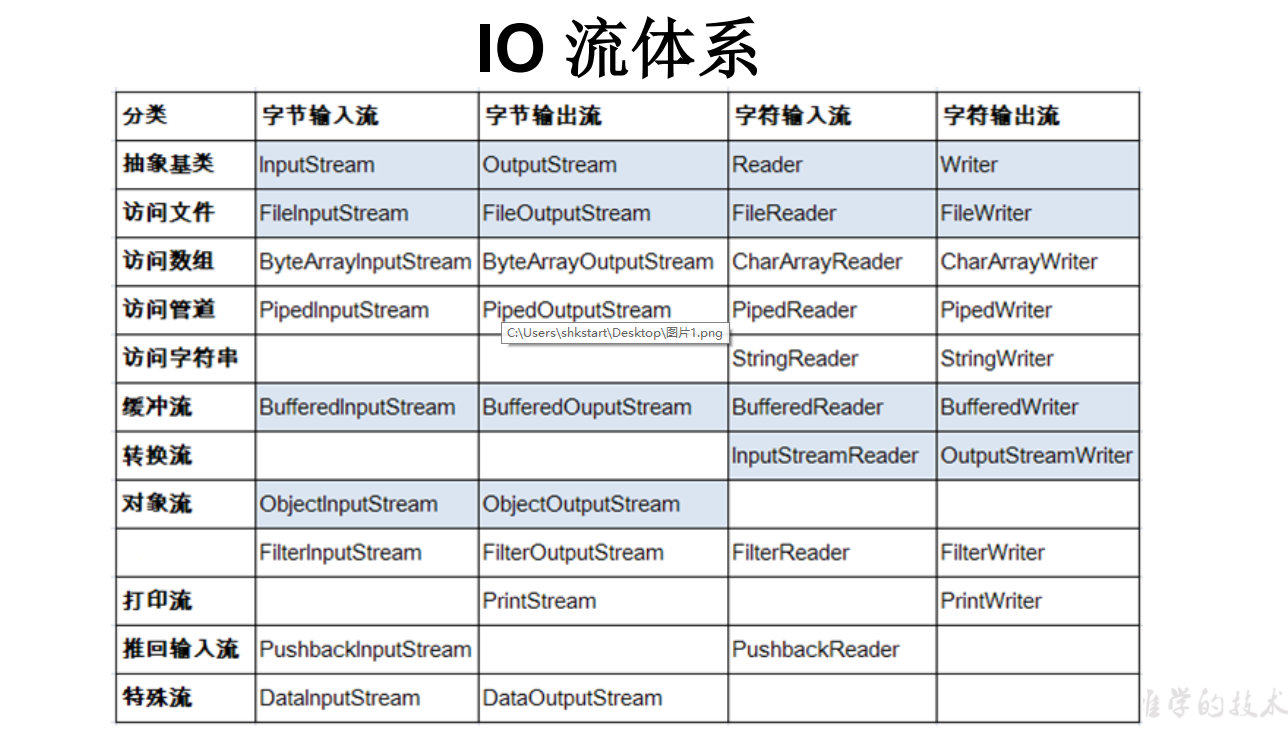15、IO流
IO 流
1、File 类的使用
File 对象主要用来获取文件本身的信息,如所在目录,文件长度,文件读/写权限等,不涉及文件的读写操作
File 类的一个对象代表一个文件目录
File 类的构造方法:
File(String filePath)File(String parentPath,String childPath)File(File parentFile,String childPath)
相对路径:相较于某个路径下,相对于「当前工程」
绝对路径:包含盘符在内的文件或文件目录的路径
相关信息
关于 File 类,流类构造器的 String 参数:
假设在桌面,当前工程下,工程下 TXT 目录中都有 test.txt 文件
FileInputStream fis1 = new FileInputStream("C:\\Users\\Tamako\\Desktop\\test.txt");
FileInputStream fis2 = new FileInputStream(".\\test.txt");
FileInputStream fis3 = new FileInputStream("test.txt");
FileInputStream fis4 = new FileInputStream("\\test.txt"); // \test.txt (系统找不到指定的文件。)
FileInputStream fis5 = new FileInputStream(".\\TXT\\test.txt");
FileInputStream fis6 = new FileInputStream(".\\TXT\\..\\test.txt");
- File 类的常用方法
public String getName(): 获取名称public String getAbsolutePath(): 获取绝对路径public String getPath(): 获取路径public String getParent(): 获取上层文件目录路径。 若无, 返回 nullpublic long length(): 获取文件长度「字节数」。不能获取目录的长度public long lastModified(): 获取最后一次的修改时间,1970 至今的毫秒值public String[] list(): 字符串形式返回目录下所有文件public File[] listFiles(): File 对象形式返回目录下所有文件public String[] list(FilenameFilter obj):字符串形式返回目录下指定类型的所有文件public File[] list(FilenameFilter obj):File 对象形式返回目录下指定类型的所有文件public String toString():返回 file 文件的路径
FilenameFilter 是一个接口,该接口有一个方法:public boolean accept(File dir,String name)
File 类的创建功能
public boolean createNewFile():file 对象调用,若文件不存在则创建文件File 类的删除功能
public boolean delete(): 文件对象调用该方法,删除文件或者文件夹
相关信息
Java 中的删除不走回收站
要删除一个文件目录, 请注意该文件目录内不能包含文件或者文件目录
File 类的重命名功能
public boolean renameTo(File dest):剪切并重命file1.renameTo(file2)
file1 在硬盘中存在,file2 不存在则执行成功File 类的判断功能
public boolean isDirectory(): 判断是否是文件目录public boolean isFile(): 判断是否是文件public boolean exists(): 判断是否存在public boolean canRead(): 判断是否可读public boolean canWrite(): 判断是否可写public boolean isHidden(): 判断是否隐藏目录创建
public boolean mkdir():创建一个目录,如果成功返回 true,如果目录已存在返回 falsepublic boolean mkdirs(): 创建文件目录。 如果上层文件目录不存在, 一并创建
File file = new File("test\\hello\\nihao");
file.mkdirs(); // 同时创建三个文件夹
相关信息
注意事项:如果你创建文件或者文件目录没有写盘符路径, 那么, 默认在 项目路径 下
- 对于文件在 main 中相较于当前工程
- 单元测试中相较于当前 model
public static void main(String[] args) {
File file = new File("hello.txt");//相较于当前工程
File file1 = new File("day09\\hello.txt");//相较于当前工程
}
public class FileTest {
@Test
public void test(){
//构造器1
File file1 = new File("hello.txt");//相对于当前module
File file2 = new File("E:\\Study\\Code\\JavaSenior\\day08\\hi.txt");
System.out.println(file1);
System.out.println(file2);
//构造器2
File file3 = new File("E:\\Study\\Code","JavaSenior");
System.out.println(file3);
//构造器3
File file4 = new File(file3,"hi.txt");
System.out.println(file4);
}
@Test
public void test2(){
File file1 = new File("hello.txt");
File file2 = new File("E:\\Study\\JavaBackend\\IO\\hi.txt");
System.out.println(file1.getAbsolutePath());
System.out.println(file1.getPath());
System.out.println(file1.getName());
System.out.println(file1.getParent());
System.out.println(file1.length());
System.out.println(new Date(file1.lastModified()));
System.out.println("----------");
System.out.println(file2.getAbsolutePath());
System.out.println(file2.getPath());
System.out.println(file2.getName());
System.out.println(file2.getParent());
System.out.println(file2.length());
System.out.println(file2.lastModified());
}
@Test
public void test3(){
File file = new File("E:\\Study\\Code\\JavaSenior");
String[] list = file.list();
for(String str : list){
System.out.println(str);
}
File[] files = file.listFiles();
for(File f : files){
System.out.println(f);
}
}
@Test
public void test4(){
File file1 = new File("hello.txt");
File file2 = new File("E:\\Study\\JavaBackend\\IO\\hi.txt");
boolean renameTo = file1.renameTo(file2);
System.out.println(renameTo);
}
@Test
public void test5(){
File file1 = new File("hello.txt");
System.out.println(file1.isFile());
System.out.println(file1.isDirectory());
System.out.println(file1.exists());
System.out.println(file1.canRead());
System.out.println(file1.canWrite());
System.out.println(file1.isHidden());
}
@Test
public void test6() throws IOException {
//文件的创建
File file1 = new File("hi.txt");
if(!file1.exists()){
file1.createNewFile();
System.out.println("创建成功");
}else{
file1.delete();
System.out.println("删除成功");
}
}
@Test
public void test7(){
//文件目录的创建
File file1 = new File("E:\\Study\\JavaBackend\\IO\\IO1");
boolean mkdir = file1.mkdir();
if(mkdir){
System.out.println("创建成功");
}
File file2 = new File("E:\\Study\\JavaBackend\\IO\\IO2");
boolean mkdir1 = file2.mkdirs();
if(mkdir1){
System.out.println("创建成功");
}
//要想删除成功,io2文件目录下不能有子目录或文件
File file3 = new File("E:\\Study\\JavaBackend\\IO\\IO2");
System.out.println(file3.delete());
}
}
运行可执行文件
当要执行一个本地可执行文件,可以使用 java.lang 包中的 Runtime 类。使用 Runtime 类声明一个对象:
Runtime rt;
rt = Runtime.getRuntime(); // 获取 Runtime 对象
File file = new File("C:/windows","Typora.exe");
try {
rt.exec(file.getAbsolutePath());
} catch (IOException e) {
throw new RuntimeException(e);
}
2、IO 流原理及流的分类



- 流的分类:
- 操作数据单位:字节流、字符流
- 数据的流向:输入流、输出流
- 流的角色:节点流、处理流
2、流的体系结构
| 抽象基类 | 节点流(或文件流) | 缓冲流(处理流的一种) |
|---|---|---|
| InputStream | FileInputStream (read (byte[] buffer)) | BufferedInputStream (read (byte[] buffer)) |
| OutputStream | FileOutputStream (write(byte[] buffer,0,len)) | BufferedOutputStream (write(byte[] buffer,0,len)) |
| Reader | FileReader (read (char[] cbuf)) | BufferedReader (read (char[] cbuf)) |
| Writer | FileWriter (write(char[] cbuf,0,len)) | BufferedWriter (write(char[] cbuf,0,len)) |
相关信息
- 对于文本文件(.txt,.java,.c,.cpp),使用字符流处理
- 对于非文本文件,使用字节流处理
3、字节流
FileInputStream 和 FileOutputStream
① FileInputStream
FileInputStream 类的构造方法:
FileInputStream(String name)FileInputStream(File file)
参数 name 和 file 指定的文件称为输入流的源,输入流通过调用 read 方法独处源中的数据
建立输入流时,可能会出现错误,比如文件不存在,此时会抛出 IOException 异常
try{
FileInputStream in = new FileInputStream("hello.txt");
} catch (IOException e){
}
InputStream 的子类都继承了它的 read 方法,该方法的特点是以字节为单位读取源中的数据:
int read():顺序读取源中的单个字节数据,返回字节值(0 - 255 的一个整数),如果达到源的末尾,返回 -1int read(byte b[]):把多个字节读到一个字节数组中,返回实际读取的字节数int read(byte b[],int off,int len)- off:首字节在数组中存放的位置
- len:读取 len 字节
- 返回实际读取的字节数
相关信息
关于 read 的相关问题:
假设 a.txt 存储 abcdef 几个字符
InputStream is = new FileInputStream(file);
while (is.read() != -1){
char c = (char) is.read();
System.out.print(c); // 输出 bdf
}
InputStream is = new FileInputStream(file);
int i;
while ((i = is.read()) != -1){
char c = (char) i;
System.out.print(c + " "); // 输出 a b c d e f
}
InputStream is = new FileInputStream(file);
byte[] b = new byte[5];
while (is.read(b) != -1){
String str = new String(b);
System.out.print(str + " "); // 输出 abcde fbcde
}
InputStream is = new FileInputStream(file);
byte[] b = new byte[5];
int len;
while ((len = is.read(b)) != -1){
String str = new String(b,0,len);
System.out.print(str + " "); // 输出 abcde f
}
InputStream is = new FileInputStream(file);
byte[] b = new byte[5];
int len;
while ((len = is.read(b,0,2)) != -1){
String str = new String(b,0,len);
System.out.print(str + " "); // ab cd ef
}
FileInputStream fis = null;
try {
//1、造文件
File file = new File("hello.txt");
//2、造流
fis = new FileInputStream(file);
//3、读数据
byte[] buffer = new byte[5];
int len;
while ((len = fis.read(buffer)) != -1){
String str = new String(buffer,0,len);
System.out.println(str);
}
} catch (IOException e) {
e.printStackTrace();
} finally {
//4、关闭资源
if(fis != null){
try {
fis.close();
} catch (IOException e) {
e.printStackTrace();
}
}
}
② FileOutputStream
FileOutputStream 类创建的对象被称为字节输出流,文件字节输出流提供了文件的写入能力
如果输出流指向的文件不存在,java 就会创建该文件,如果指向的文件是已存在的文件,输出流将刷新该文件
FileOutputStream 类构造方法
FileOutputStream(String name)FilePutputStream(File file)FileOutputStream(String name,boolean append)FilePutputStream(File file,boolean append)
参数 name 和 file 指定的文件称为输出流的目的地
如果参数 append 为 true,输出流不会刷新该文件,write 方法将从文件末尾开始向文件写入数据
如果 apepend 为 false,输出流将刷新该文件
字节流 OutputStream 的子类都继承了 write(byte b[]) 方法,该方法已字节为单位向文件写入数据
public void wirte(byte b[])public void write(byte[],int off,int len)- off 为数据的起始偏移量
- len 要写出的字节数
注意
FileOutStream 流顺序地写文件,只要不关闭流,每次调用 write 方法就顺序地向文件写入内容,直到流被关闭(写文件时,一定要先关闭流,再执行后续操作)
read 方法顺序地读取文件,只要不关闭流,每次调用 read 都会顺序读取文件的其余内容,直到文件的末尾或文件直接输入流被关闭
public class FileInputOutputStreamTest {
/*
* 实现对图片的复制
*/
@Test
public void testFileInputOutputStream(){
FileInputStream fis = null;
FileOutputStream fos = null;
try {
//1、创文件
File scrFile = new File("tamakoTest.jpg");
File destFile = new File("tamakoTest2.jpg");
//2、创流
fis = new FileInputStream(scrFile);
fos = new FileOutputStream(destFile);
//3、读数据
byte[] buffer = new byte[5];
int len;
while((len = fis.read(buffer)) != -1){
fos.write(buffer,0,len);
}
} catch (IOException e) {
e.printStackTrace();
} finally {
//4、关闭流
try {
if (fos != null)
fos.close();
} catch (IOException e) {
e.printStackTrace();
}
try {
if (fis != null)
fis.close();
} catch (IOException e) {
e.printStackTrace();
}
}
}
//指定路径下文件的复制方法的创建
public void copyFile(String srcPath,String destPath){
FileInputStream fis = null;
FileOutputStream fos = null;
try {
//1、创文件
File scrFile = new File(srcPath);
File destFile = new File(destPath);
//2、创流
fis = new FileInputStream(scrFile);
fos = new FileOutputStream(destFile);
//3、读数据
byte[] buffer = new byte[1024];
int len;
while((len = fis.read(buffer)) != -1){
fos.write(buffer,0,len);
}
} catch (IOException e) {
e.printStackTrace();
} finally {
//4、关闭流
try {
if (fos != null)
fos.close();
} catch (IOException e) {
e.printStackTrace();
}
try {
if (fis != null)
fis.close();
} catch (IOException e) {
e.printStackTrace();
}
}
}
}
4、字符流
FileReader 和 FileWriter
字节流不能很好的操作 Unicode 字符,使用字节流读取不当会出现「乱码」现象
字符流类 FileReader 和 FileWriter 分别是 Reader 和 Writer 类
构造方法:
FileReader(String filename)FileReader(File filename)FileWriter(String filename)FileWriter(File filename)FileWriter(File filename,boolean append):append 为 false,对文件覆盖,append 为 true 对文件的追加
字符流的 read() 和 witre() 方法:
int read():读取一个字符,返回一个整数(0 - 65535),未读出返回 -1int read(char[] b):从流中读取 b.length 个字符到数组 b 中,返回实际读取字符数目,如果打达到末尾返回 -1int read(char b[],int off,int len):读取 len 个字符到数组中,off 是首字符在数组中存放位置,返回实际读取数。如果到达文件末尾,返回 -1int write(int n):向文件写入「一个」字符int write(char[] b):向文件写入一个字符数组int write(char[] b,int off,int len):将数组中位于 off 出取出 len 个字符写到文件
注意
- write 方法将数据先写入缓冲区,当缓冲区溢出时,缓冲区内容自动写到目的地,若流关闭,缓冲区内容立即被写入目的地。
- 调用
flush()方法可以立即刷新缓冲区,将当前缓冲区的内容写入目的地
public void testFileReader(){
FileReader fr = null;
try {
//1. File 类的实例化
File file = new File("hello.txt");
//2、FileReader 流的实例化
fr = new FileReader(file);
//3、数据读入
//方式一:
/*
int data = fr.read();
while (data != -1){
System.out.print((char) data);
data = fr.read();
}*/
//方式二:语法上的修改
int data;
while ((data = fr.read()) != -1){
System.out.print((char)data);
}
} catch (IOException e) {
e.printStackTrace();
}finally {
try {
if(fr!=null)
//4、流的关闭操作
fr.close();
} catch (IOException e) {
e.printStackTrace();
}
}
}
public void testFileReader1() {
FileReader fr = null;
try {
//1、File 类的实例化
File file = new File("hello.txt");
//2、FileReader 流的实例化
fr = new FileReader(file);
//3、数据读入
char[] cbuf = new char[5];
int len;
while ((len = fr.read(cbuf)) != -1){
String str = new String(cbuf,0,len);// String 的构造方法
System.out.println(str);
}
} catch (IOException e) {
e.printStackTrace();
} finally {
if (fr != null) {
try {
//4、资源的关闭
fr.close();
} catch (IOException e) {
e.printStackTrace();
}
}
}
}
@Test
public void testFileWriter() {
FileWriter fw = null;
try {
//1、File 类的实例化
File file = new File("hello1.txt");
//2、FileWriter 的实例化
fw = new FileWriter(file,true);// 追加
//3、写出的操作
fw.write("I have a dream!\n");
fw.write("you need to have a dream");
} catch (IOException e) {
e.printStackTrace();
} finally {
//4、流的关闭
if(fw != null)
try {
fw.close();
} catch (IOException e) {
e.printStackTrace();
}
}
}
共用 FileReader 和 FileWriter
public void testFileReaderFileWriter(){
FileReader fr = null;
FileWriter fw = null;
try {
//1、File 类的实例化
File srcFile = new File("hello.txt");
File destFile = new File("hello2.txt");
//2、流的实例化
fr = new FileReader(srcFile);
fw = new FileWriter(destFile);
//3、数据的读入和写出的操作
char[] cbuf = new char[5];
int len;//记录每次读入到cbuf数组中字符的个数
while ((len = fr.read(cbuf)) != -1){
//每次写入 len 个字符
fw.write(cbuf,0,len);
}
} catch (IOException e) {
e.printStackTrace();
} finally {
//4、关闭流资源
//方式一:
/*try {
if(fw != null)
fw.close();
} catch (IOException e) {
e.printStackTrace();
}finally {
try {
if(fr !=null )
fr.close();
} catch (IOException e) {
e.printStackTrace();
}
}*/
//方式二:
//调用 try-catch 处理完异常,尽管出现了异常,try-catch-finally 的后续代码依旧执行
try {
if(fr != null)
fr.close();
} catch (IOException e) {
e.printStackTrace();
}
try {
if(fw != null)
fw.close();
} catch (IOException e) {
e.printStackTrace();
}
}
}
5、缓冲流
缓冲输入输出流:
- BufferedInputStream
- BufferedOutputStream
- BufferedReader
- BufferedWriter
FileReader 的局限性:没有读取提供一行的方法
缓冲流:有更强的读/写能力,内部提供了一个缓冲区,提升流的读取、写入速度
BufferedReader 和 BufferedWriter 类的构造方法:
BufferedReader(Reader in)BufferedWriter(Writer out)
BufferedReader 流能读取文本行,即 readLine() 方法
BufferedWriter 流向文件写入一个回行符的方法 newLine()
相关信息
把 BufferedREader 和 BufferedWriter 称为「上层流」,把它们指向的流称为「底层流」
Java 使用缓存技术将上层流和底层流连接
- 底层字符输入流首先将数据输入缓存,BufferedReader 流再从缓存读取数据
- BufferedWriter 流将数据写入缓存,底层字符输出流会不断将缓存中的数据写入目的地。当 BufferedWriter 流调用 flush() 或 close() 时,底层流立即将缓存的内容写入目的地
关闭外层流的同时,内层流也会自动关闭,关于内层流的关闭代码可以省略
注意下方代码有 bw.close();(bw.flush(); 效果相同) 和没有的区别:
- 有
bw.close();输出语句输出文件原先的内容与新增的内容 - 没有
bw.close();只输出文件原先的内容 - 如果 FileWriter 构造器的 append 为 false,无输出内容
BufferedReader bf = null;
BufferedWriter bw = null;
try {
bf = new BufferedReader(new FileReader(new File("C:\\Users\\Tamako\\Desktop\\a.txt")));
bw = new BufferedWriter(new FileWriter(new File("C:\\Users\\Tamako\\Desktop\\b.txt"),true));
String str = null;
while((str = bf.readLine()) != null){
bw.write(str);
bw.newLine();
}
// bw.close();
bf = new BufferedReader(new FileReader(new File("C:\\Users\\Tamako\\Desktop\\b.txt")));
char[] c = new char[2];
int len = 0;
while((len = bf.read(c)) != -1){
System.out.print(new String(c,0,len));
}
} catch (IOException e) {
throw new RuntimeException();
}
// 操作 BufferedInputStream、BufferedOutputStream
public class BufferedTest {
public void BufferedStreamTest(){
BufferedInputStream bis = null;
BufferedOutputStream bos = null;
try {
//1、File 实例化
File src = new File("tamakoTest.JPG");
File dest = new File("tamakoTest3.JPG");
//2.1、节点流实例化
FileInputStream fis = new FileInputStream(src);
FileOutputStream fos = new FileOutputStream(dest);
//2.2、缓冲流实例化
bis = new BufferedInputStream(fis);
bos = new BufferedOutputStream(fos);
//3、复制的细节:读取和写入
byte[] buffer = new byte[10];
int len;
while ((len = bis.read(buffer)) != -1){
bos.write(buffer,0,len);
}
} catch (IOException e) {
e.printStackTrace();
} finally {
//4、资源关闭
//先关外层流,再关内层的流
if(bos != null){
try {
bos.close();
} catch (IOException e) {
e.printStackTrace();
}
}
if(bis != null){
try {
bis.close();
} catch (IOException e) {
e.printStackTrace();
}
}
}
}
// 使用 BufferedReader 和 BufferedWriter 实现文本文件的复制
public void testBufferedReaderBufferedWriter(){
BufferedReader br = null;
BufferedWriter bw = null;
try {
//创建文件和相应资源
br = new BufferedReader(new FileReader(new File("hello.txt")));
bw = new BufferedWriter(new FileWriter(new File("hello3.txt")));
// 读写操作
// 方式一:使用 char 数组
// char[] cbuf = new char[1024];
// int len;
// while ((len = br.read(cbuf))!=-1){
// bw.write(cbuf,0,len);
// }
//方式二:使用 String
String data;
while((data = br.readLine())!=null){
//方法一:
bw.write(data+"\n");// data中不包含换行符
//方法二:
bw.write(data);
bw.newLine();//提供换行的操作
}
} catch (IOException e) {
e.printStackTrace();
} finally {
//关闭资源
if(bw != null){
try {
bw.close();
} catch (IOException e) {
e.printStackTrace();
}
}
if(bw != null){
try {
br.close();
} catch (IOException e) {
e.printStackTrace();
}
}
}
}
6、随机流
RandomAccessFile 类创建的对象叫随机访问文件流
该类创建的流既可以作为「源」也可以作为「目的地」
即要对一个文件进行读写操作时,创建一个随机访问文件流即可
RandomAccessFile 类的构造方法:
RandomAccessFile(String name,String mode)RandomAccessFile(File file,String mode)
参数 name 和 file 用来确定一个文件名或 file 对象
参数 mode 取 r(只读)或 rw(可读/写),决定流对文件的访问权限
RandomAccessFile 类常用方法:
| 方法 | 描述 |
|---|---|
| close() | 关闭文件 |
| getFilePointer() | 获取当前读写位置 |
| length() | 获取文件长度 |
| read() | 从文件中读取一个字节的数据 |
| readBoolean() | 从文件中读取一个 bool 值,0 代表 false,其他代表 true |
| readByte() | 读取一个字节 |
| readChar() | 读取一个字符(两个字节) |
| readDouble() | 读取一个双精度浮点值(8 个字节) |
| readFloat() | 读取一个单精度浮点值(4 个字节) |
| readFully(byte[] b) | 读取 b.length 字节放入数组 b,完全填满该数组 |
| readInt() | 读取一个 int 值(4 字节) |
| readLine() | 读取一个文本行 |
| readLong() | 读取一个 long 值(8 字节) |
| readShort() | 读取一个 short 值(2 字节) |
| readUnsignedShort() | 读取一个无符号 short |
| readUTF() | 读取一个 UTF 字符串 |
| seek(long position) | 定位读/写位置 |
| setLength(long newlength) | 设置文件长度 |
| skipBytes(int n) | 在文件中跳过给定数量的字节 |
| write(byte b[]) | 写 b.length 字节到文件 |
| writeBoolean(boolean v) | 把一个布尔值作为单字节写入文件 |
| writeByte(int v) | 写入一个字节 |
| writeBytes(String s) | 写入一个字符串 |
| writeChar(char c) | 写入一个字符 |
| writeChars(String s) | 写入一个作为字符数据的字符串 |
| writeDouble(double v) | 写入一个 double 值 |
| writeFloat(float v) | 写入一个 float 值 |
| writeInt(int v) | 写入一个 int 值 |
| writeLong(long v) | 写入一个 long 值 |
| writeShort(int v) | 写入一个 短型 int 值 |
| writeUTF(String s) | 写入一个 UTF 字符串 |
public static void main(String[] args) throws IOException {
RandomAccessFile in = null;
try{
in = new RandomAccessFile("test.txt","rw");
long length = in.length(); // 获取文件的长度
long position = 0;
in.seek(position); // 定位到开始位置
while (position < length){
String str = in.readLine(); // 读取一行
byte[] b = str.getBytes("ISO-8859-1"); // 重新编码
str = new String(b);
position = in.getFilePointer(); // 获取当前读写位置
System.out.println(str);
}
}catch (IOException e){
}
}
7、数据流
DateInputStream 和 DataOutputStream 类创建的对象称为数据输入流和数据输出流。
这两个流读取一个值时,不必在关心这个数值应当是多少字节。
DateInputStream 和 DataOutputStream 类的构造方法:
- DataInputStream(InputStream in)
- DataInputStream(OutputStream out)
DateInputStream 和 DataOutputStream 类的常用方法:
| 方法 | 描述 |
|---|---|
| close() | 关闭流 |
| readBoolean/Byte/Char/ Double/Float/Int/ Long/Short/UnsignedByte/UnsignedShort() | 读取 |
| readUTF() | 读取一个 UTF 字符串 |
| skipBytes(int n) | 跳过给定一个数量的字节 |
| writeBoolean/Bytes/Chars/Double/Float/Int/Long/Short(类型 s) | 写入 |
| writeUTF(String s) | 写入一个 UTF 字符串 |
File file = new File("test.txt");
try {
FileOutputStream fos = new FileOutputStream(file);
DataOutputStream dos = new DataOutputStream(fos);
dos.writeDouble(123.45);
dos.writeChars("abcd");
} catch (IOException e) { }
try{
FileInputStream fis = new FileInputStream(file);
DataInputStream dis = new DataInputStream(fis);
System.out.println(dis.readDouble());
char c;
while ( (c = dis.readChar()) != '\0'){ // '\0' 表示空字符
System.out.println(c);
}
}catch (IOException e){ }
8、对象流
ObjectOutputStream 和 ObjectInputStream 类分别是 InputStream 和 OutputStream 类的子类
- 对象输出流使用
writeObject(Object obj)方法将一个对象 obj 写入一个文件 - 对象输出流使用
readObject()方法读取一个对象到程序中,读取的返回值类型为 Object
ObjectOutputStream 和 ObjectInputStream 类构造方法:
ObjectOutputStream(InputStream in)ObjectInputStream(OutputStream out)
「序列化」与「反序列化」:
- 序列化: 用
ObjectOutputStream类保存基本类型数据或对象的机制 - 反序列化: 用
ObjectInputStream类读取基本类型数据或对象的机制
对象克隆:
- 浅拷贝:调用 Object 的 clone() 即可
- 深拷贝:使用对象序列化
作用:用于存储和读取基本数据类型数据或对象的处理流。将内存中的 java 对象保存到磁盘中或通过网络传输出去
- 要想一个 java 对象是可序列的,应满足下列要求:
- 需要实现
Serializable接口 - 还须保证其内部的所有属性也必须是可序列化的(默认情况下,基本数据类型都是可序列化的)
- 序列化机制:对象序列化机制允许把内存中的 Java 对象转换成平台无关的二进制流,从而允许把这种二进制流持久地保存在磁盘上,或通过网络将这种二进制流传输到另一个网络节点。
- 需要实现
相关信息
- Serializable 接口中没有方法,接口中的方法对程序是不可见的
- 当把一个序列化对象写入对象输出流时,JVM 会实现 Serializable 接口中的方法,将一定格式的文本(对象序列化信息)写入目的地。当 ObjectInputStream 对象流从文件读取对时,就会从文件中读取对象的序列化信息,并根据该信息创建对象
- ObjectOutputStream 和 ObjectInputStream 不能序列化 static 和 transient 修饰的成员变量
public void testObjectOutputStream(){
ObjectOutputStream oos = null;
try {
oos = new ObjectOutputStream(new FileOutputStream("object.dat"));
oos.writeObject(new String("luv u"));
oos.flush();
oos.writeObject(new Person(20,"AA"));
oos.flush();
} catch (IOException e) {
e.printStackTrace();
} finally {
if(oos != null){
//3
try {
oos.close();
} catch (IOException e) {
e.printStackTrace();
}
}
}
}
public void testObjectInputStream(){
ObjectInputStream ois = null;
try {
ois = new ObjectInputStream(new FileInputStream("object.dat"));
Object obj = ois.readObject();
String str = (String)obj; // 强转
Person p = (Person) ois.readObject();
System.out.println(str);
System.out.println(p);
} catch (IOException e) {
e.printStackTrace();
} catch (ClassNotFoundException e) {
e.printStackTrace();
} finally {
if(ois != null){
try {
ois.close();
} catch (IOException e) {
e.printStackTrace();
}}}}
7、转换流
转换流:属于字符流
- InputStreamReader:将一个字节的输入流转换为字符的输入流
- OutputStreamWriter:将一个字符的输出流转换为字节的输出流
作用:提供字节流与字符流之间的转换
解码:字节、字节数组 --> 字符数组、字符串
编码:字符数组,字符串 --> 字节、字节数组
public class InputStreamReaderTest {
//此时处理异常的话,仍应使用try-catch-finally
@Test
public void test1() throws IOException {
FileInputStream fis = new FileInputStream("dbcp.txt");
//InputStreamReader isr = new InputStreamReader(fis);//使用系统默认的字符集
//参数2:指明字符集,具体使用哪个字符集取决于文件保存时使用的字符集
InputStreamReader isr = new InputStreamReader(fis, "UTF-8");
char[] cbuf = new char[200];
int len;
while((len = isr.read(cbuf)) != -1){
String str = new String(cbuf,0,len);
System.out.println(str);
}
isr.close();
}
@Test
public void test2() throws IOException {
//1、造文件、造流
File file1 = new File("dbcp.txt");
File file2 = new File("dbcp_GBK.txt");
FileInputStream fis = new FileInputStream(file1);
FileOutputStream fos = new FileOutputStream(file2);
InputStreamReader isr = new InputStreamReader(fis,"utf-8");
OutputStreamWriter osw = new OutputStreamWriter(fos,"gbk");
//2、读写过程
char[] cbuf = new char[200];
int len;
while((len = isr.read(cbuf)) != -1){
//System.out.println(cbuf);
osw.write(cbuf);
}
//3、资源关闭
isr.close();
fos.close();
}
}
8、其他流的使用
1、标准的输入输出流
System.in:标准的输入流,默认从键盘输入System.out:标准的输出流,默认从控制台输出
System 类的 setIn(InputStream is),setOut(printStream ps) 方式重新指定输入和输出的流
//练习:从键盘输入字符串,要求将读取到的整行字符串转成大写输出。然后继续
//进行输入操作,直至当输入 e 或者 exit 时,退出程序。
//方法一:Scanner 实现,调用 next() 返回字符串
//方法二:System.in 实现(System.in --> 转换流 --> BufferedReader的readline()
public class OtherStreamTest {
public static void main(String[] args){
BufferedReader br = null;
try {
InputStreamReader isr = new InputStreamReader(System.in);
br = new BufferedReader(isr);
while (true){
String data = br.readLine();
if ("e".equalsIgnoreCase(data)||"exit".equalsIgnoreCase(data)){
System.out.println("break");
break;
}
String upperCase = data.toUpperCase();
System.out.println(upperCase);
}
} catch (IOException e) {
e.printStackTrace();
} finally {
if(br != null) {
try {
br.close();
} catch (IOException e) {
e.printStackTrace();
}
}
}
}
}
2、打印流
- 打印流:PrintStream 和 PrintWriter
- 提供了一系列重载的 print() 和 println()
//练习:
PrintStream ps = null;
try {
FileOutputStream fos = new FileOutputStream(new File("D:\\IO\\text.txt"));
// 创建打印输出流,设置为自动刷新模式(写入换行符或字节 '\n' 时都会刷新输出缓冲区)
ps = new PrintStream(fos, true);
if (ps != null) {// 把标准输出流(控制台输出)改成文件
System.setOut(ps);
}
for (int i = 0; i <= 255; i++) { // 输出ASCII字符
System.out.print((char) i);
if (i % 50 == 0) { // 每50个数据一行
System.out.println(); // 换行
}
}
} catch (FileNotFoundException e) {
e.printStackTrace();
} finally {
if (ps != null) {
ps.close();
}
}
9、文件锁
若有几个程序同时处理一个文件,可能会发生混乱
JDK 1.4 后 Java 提供了文件锁
FileLock、FileChannel 类分别在 java.nio 和 java.nio.channels 包中。输入流、输出流读/写文件时可以使用文件锁
使用 RandomAccessFile 类说明文件锁的使用方法:
RandomAccessFile in = new RandomAccessFile("test.txt","rw"); // 创建随机流对象,读写属性为 rw
FileChannel channel = in.getChannel(); // 获得一个连接到底层文件的 FileChannel 对象
FileLock lock = channel.tryLock(); // 通过 tryLock() 或 lock() 方法给文件加锁,获得一个 FileLock(锁)对象
lock.release(); // 释放锁
相关信息
文件加锁后,将禁止任何程序对文件进行操作或再加锁
对一个文件加锁后,如果想读/写文件,必须让 FileLock 对象调用 realse() 方法释放锁